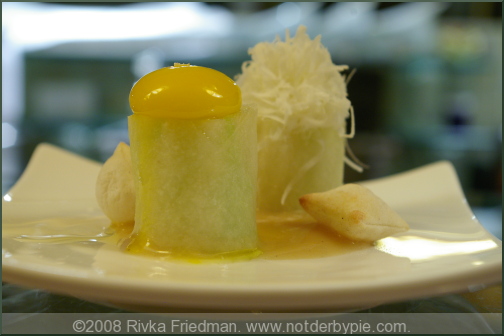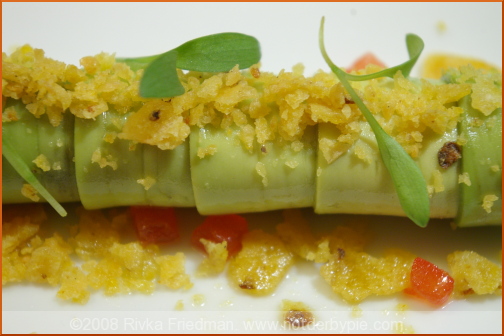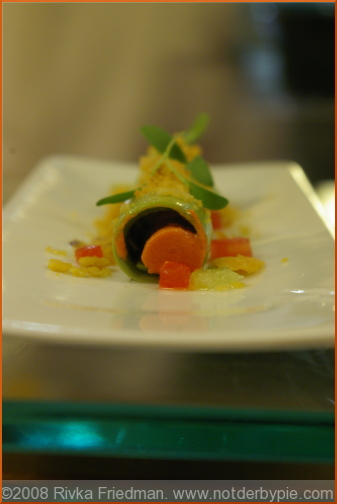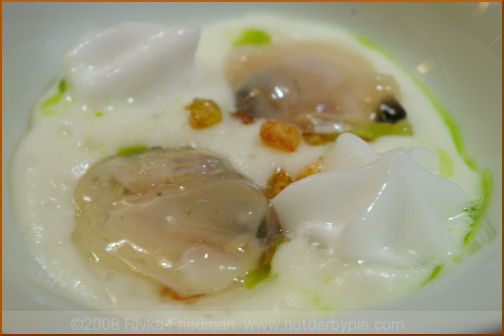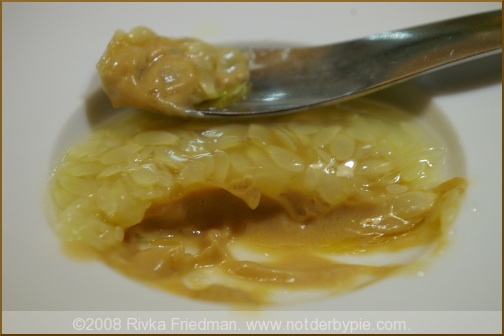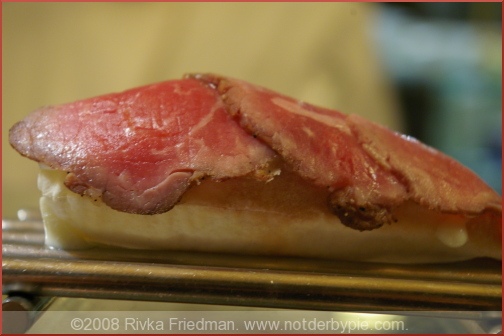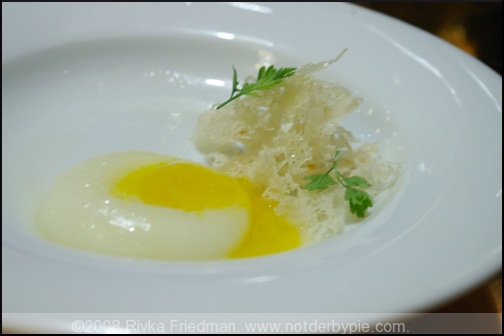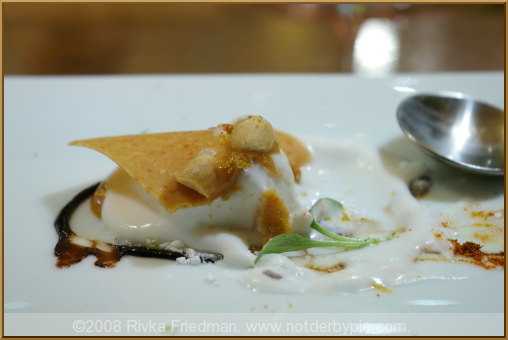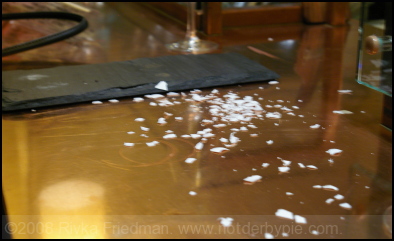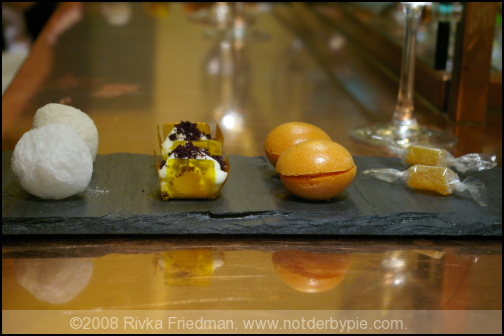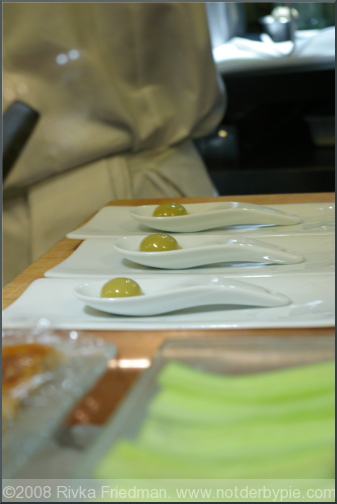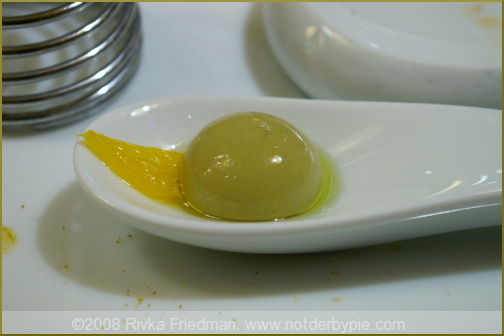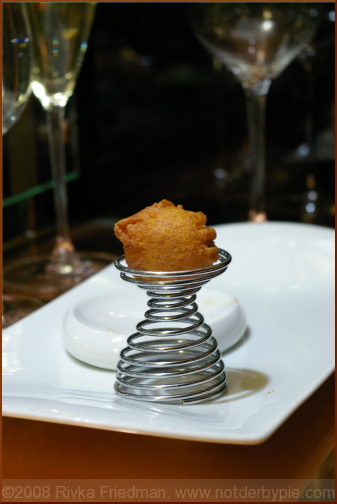 If I had my way, I'd have many more dinners like Thursday night's feast at Minibar; that said, it's safe to assume that food that memorable won't pass my lips again for quite a long time. I know it's not my usual tune to do restaurant reviews, but Thursday night was truly revolutionary, and I'd be remiss not to share it with my readers, who surely appreciate the value of a spectacular meal.
If I had my way, I'd have many more dinners like Thursday night's feast at Minibar; that said, it's safe to assume that food that memorable won't pass my lips again for quite a long time. I know it's not my usual tune to do restaurant reviews, but Thursday night was truly revolutionary, and I'd be remiss not to share it with my readers, who surely appreciate the value of a spectacular meal.
Two friends, E and J, recently celebrated their birthdays; E impressively convinced J and four other rational people to shell out an arm and a few legs to eat what rarely consisted in things we'd call "food." Main ingredients in many of the dishes included liquid nitrogen; agar agar; sodium alginate; calcium chloride; and other lip-smacking ingredients. Odd chemicals notwithstanding, each course was both tasty and fun to eat. In fact, fun was pretty much the theme of Thursday night's feast. Minibar is a restaurant that doesn't take itself too seriously; there's a fair amount of silliness involved when you're eating things that make you exhale smoke.
Minibar is owned and run by the formidable DC restauranteur Jose Andres (also of Jaleo, Oyamel, Cafe Atlantico, and Zaytinya); it comprises -- yep, you guessed it -- a bar (and a short one at that) on the second-and-a-half floor of Cafe Atlantico. Six seats across, the "restaurant" is designed to serve three groups of two a 28-course dinner, spanning two hours, of "snacks," "savories," and "sweet endings." The chefs behind the bar (Brad and Ryan were ours, but the team is six in total) take great care in assembling each course, and the results are both whimsical and clever.
Over the next few posts, I'll provide some highlights of this meal, along with some tips for recreating the dishes in your own kitchen. I asked how to make almost all of the 28 courses we had on Thursday night; however, many of them required a pacojet, a cotton candy maker, and other kitchen tools and appliances whose names I don't even know. With that in mind, my caveat to providing some of their methods is that when you go home to make these dishes, aim to replicate the tastes, but accept that some of the textures will be impossible to recreate without some specialty kitchen items.
Ok, here we go: (SPOILER ALERT: if you're going to minibar sometime soon, do yourself the favor of refraining from reading this. Better to be surprised onsite!)
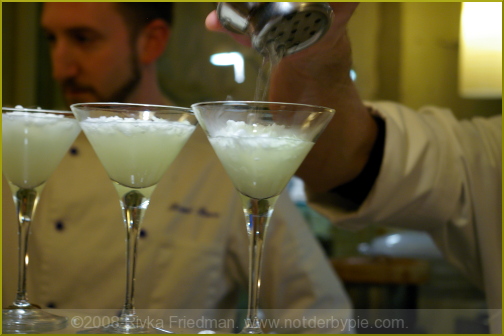
Course #1: Caipirinha "Nitro": picture a martini glass filled with a nice, strong caipirinha, and topped with what amounted to shards of caipirinha sorbet. I'm not 100% sure how they managed to freeze the alcohol, but I think dry ice may have been involved; in any event, the idea was that the "ice" in the drink was made of more drink, so that when it melted it didn't dilute the drink at all. Clever, but not one of my favorites. This was likely because at that point, we had glasses of champagne sent by a friend, and glasses of the white wine we had ordered, both in front of us already; it was a bit of alcohol overkill, especially on an empty stomach.
The idea of making drink flavored ice cubes is clever and useful; I often do it when making a pitcher of iced coffee, so that people can keep their coffee both cold and strong.
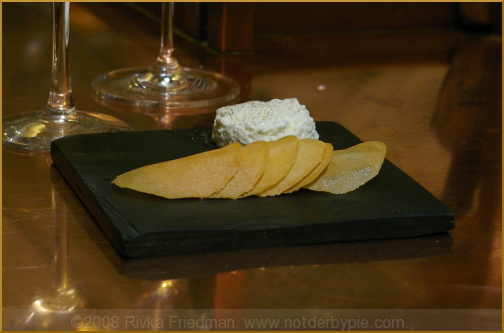
Course#2: Parmesan "Pringle" (yea, almost every course has at least one word in quotations): paper-thin sheets of toasted parmesan were shaped to resemble pringles, and were served with a delightful dip made of greek yogurt, lemon, and some herbs. This course was really delicious; the salty parmesan chips went perfectly with the creamy and acidic dip. Perhaps the best part was that while the so-called pringles were incredibly thin and delicate, the yogurt dip was so light and fluffy that you could scoop it onto a pringle without the chip breaking into a million shards the way you might expect it to. Very cool.

When I was younger, I used to make pita pizza for dinner at least once a week. Parmesan was my preferred pizza cheese, and I'd always make sure to grate extra cheese onto the pan so that along with my pita pizza, I could eat small sheets of browned parmesan cheese. These days, I don't bother with the pita pizza; I just grate parmesan onto a baking sheet lined with foil in a 350-degree oven for 15 minutes or so, until the cheese is fully browned. I remove it from the oven, let it cool slightly, and then crack it into "chips," to be eaten with a dip of your choice, if not plain.
As for the dip, it is relatively easy to make a fluffy greek yogurt dip at home: simply whip the yogurt with a hand or stand mixer, and add salt, pepper, a few squeezes of lemon and some fresh parsley, mint, chili pepper, or other herbs and spices.
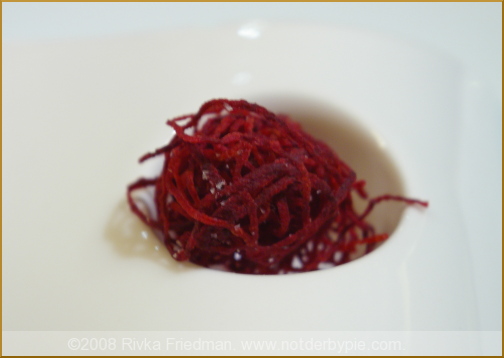
Course#3: Beet "Tumbleweed." If there was a throwaway course, this was it. The tumbleweed was essentially a bunch of terra sticks made into a tangled ball. It was good, but it tasted no more interesting or flavorful than terra chips. I suppose that to make these at home, you would slice a beet into matchsticks, season with salt and pepper, bake, and then fry. Or maybe just fry raw. Anyhow, buy Terra chips or sticks and avoid the hassle.

Course#4: Olive Oil "bon bon:" Do you watch Top Chef? If you recall the final episode of season 2, when Marcel and Ilan cooked in Hawaii, Marcel attempted making something just like this, but the humidity foiled his plans. Essentially, the olive oil bon bon consisted in a fantastic Spanish olive oil and a hit of salt held together with sodium alginate inside a thin layer of sugar, such that it formed a glassy marble-like bottom with a long, slender pipette at the top. We were instructed to lift by the bulb, as the shard of sugar was very delicate. Cracking the sugar released a small rush of wonderfully-flavored olive oil, which blended nicely with the salt and sugar.
Not surprisingly, I can't tell you how to make this at home.
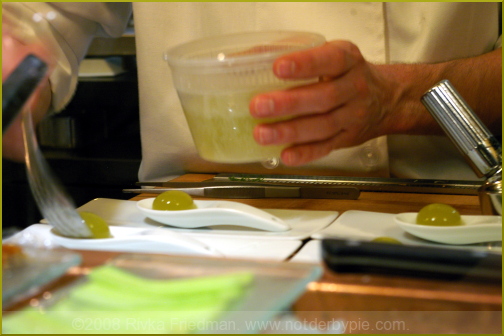
Course#5: "Mojito:" this was in quotations because it was prepared using some agar agar so that the outside gelled to resemble an egg yolk, with a thin mojito-flavored membrane surrounding the sweet, rum-y, limey innards. There was just a bit of lime zest on top. Once in your mouth, the membrane burst and the mojito went down easily; this mouthfeel would recur several times during the meal.
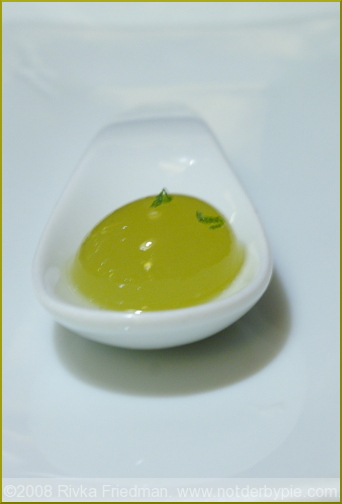
No tips for this one, either -- sorry, folks.
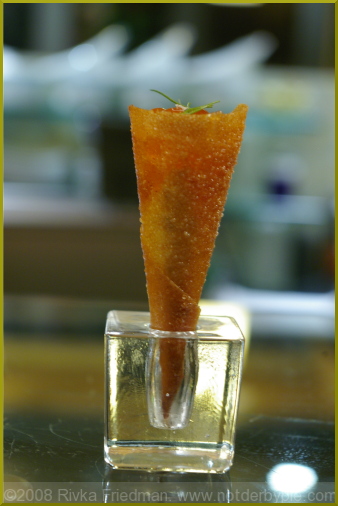
Course#6: "Bagles and Lox:" A clever twist on the original, this was deep-fried Greek pastry filled with tobiko ikura (salmon roe) and home-made (I think) herbed cream cheese. The bite contained perfect proportions of each (read: lots of roe, little cream cheese) and the crispy pastry, neither sweet nor salty, was the perfect vehicle for the creamy and salty filling. Most of us really enjoyed this.
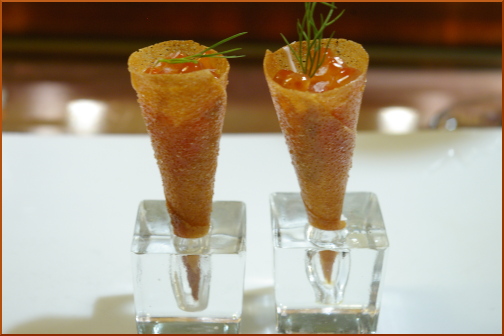
I actually plan on making this at home at some point, and here's how I'll be doing it: I'll buy wanton wrappers, and slice them into thin isosceles triangle, wrap them around themselves into a cone shape, stick together with a bit of water, and deep fry. You may have to set them around something structured so that they hold their shape. After they've been fried and cooled, make the cheese: mix equal parts cream cheese and either Alouette or Boursin cheese. You only need like 1/2 a tsp. total for each cone. Put half the cheese mix in; top with a couple tsp. of tobiko and a bit more cheese. And maybe a bit of lemon zest would go nicely with it as well.
That's enough for now, but hang around for more courses during the next couple weeks. What a meal this was!
